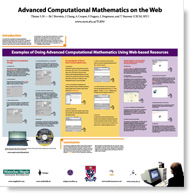Advanced Computational Mathematics on the Web (January 2001)
 Winner of the People's Choice Award at TeleLearning 2000 Annual Conference.
Winner of the People's Choice Award at TeleLearning 2000 Annual Conference.
As content-on-the-web moves front and centre we have
concentrated on research and development that attacks the issue of how
sophisticated components may be connected so that relatively naive
users may benefit substantially. This poster will concentrate on
three such pieces:
1. IntegerRelations, CECM's latest interface, implements various fast
methods for "for spotting simple equations satisfied by collections of
seemingly unrelated numbers."
One attraction of this tool is that the underlying algorithm needs
highly sophisticated computation and has been ranked as one of the ten
algorithms having "the greatest influence on the development and practice of
science and engineering in the 20th century" in the
January/February 2000 issue of 'Computing in Science & Engineering'.
It features an email submission option that allows for automated data
analysis through the use of the nterface's robot. IntegerRelations has
a web-based counterpart and is built to determine linear integer
dependence among numerical constants and to determine the minimal
polynomial of an approximate algebraic number.
IntegerRelations is designed to be a self-contained "portal" for the
topic.
2. The Graph Explorer, correspondingly, illustrates how Java can be
seriously used over the web in college mathematics. This JAVA applet
allows one to smoothly zoom in and out or pan across the graphs of
functions that one defines, and also to set and vary the values of literal
"parameters" that one may include in one's formulas. Its animated zoom
and pan features may give a better feel for scaling relationships than
one can get from a graphing calculator (or even from some much more
sophisticated Computer Algebra Systems).
3. Developed by our partners in Berlin, JavaView, a sophisticated 3D
package, allows true visualization on the web. It is sufficiently
flexible as we indicate that it can "grab Maple" and other packages,
enhance their output and return that enhanced outout to
the originating software.
|



